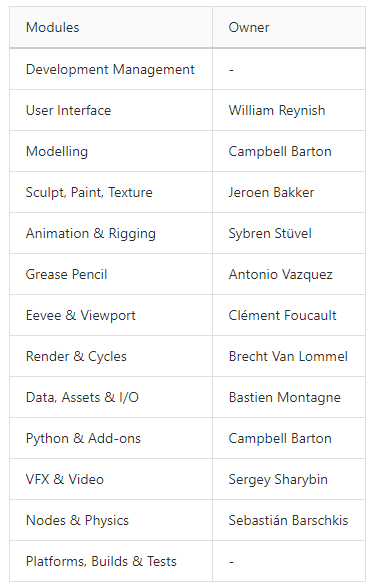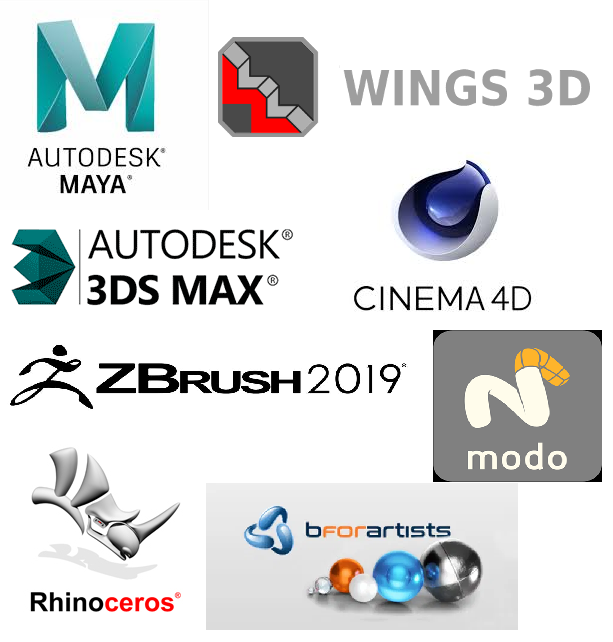Blender aims to “build a free and open source complete 3D creation pipeline for artists and small teams, by publicly managed projects on blender.org”.1 That is, Blender wants to offer functionalies of the entire 3D creation pipeline. This “3D creation pipeline” refers to all the stages towards 3D pre-rendered or real-time imagery: modeling and/or sculpting, rigging, animation, simulation, rendering, compositing, motion tracking, and even video editing.2
In order to achieve this vision, Blender’s development team is constantly working together with its contributors from all over the world to improve and meet the needs of its users, as well as catch up with its competitors. Towards this end goal, one recent major change was the UI overhaul in update 2.8, released in July 2019. Before the update, the UI of Blender used to be its most salient source of criticism, and this revamp has arguably brought Blender on par with its $1000-a-year-costing competitors3 with regards to usability. Personally, we anticipate Blender to become the industry standard at some point, especially given its current rapid development momentum. The 2.8 update also included a brand new real-time rendering engine, called EEVEE. This engine complements Blender’s older Cycles engine, a physically-based — which can more or less be interpreted as meaning “photorealistic” — path tracer. Where Cycles is slower but more realistic, EEVEE is much faster and more akin to a game engine renderer, in that it uses rasterization rather than path tracing. Another noteworthy function of Blender is its grease pencil tool, which allows for 2D drawing and animation. Since the 2.8 update, two more updates have released, each with a host of new features and improvements. This brings the current version to 2.82, as of writing.
We feel Blender to be a tremendous project, centered around the core principles of enabling creativity and sharing those creations with as little involvement of monetary considerations as possible. Blender enables small animation studios, game developers or artists to save thousands of dollars a year, while still having the functionality and ease-of-use they desire, with no strings attached.
Blender’s most distinguishing property is that Blender is free for anyone to use. The license they use is GNU GPL v2.4 They also wrote a blog post about Blender’s freedom5. This means:
- Blender is free to use
- You can study the source code of Blender and modify it
- You can freely redistribute Blender and its modified versions
- Anything created using Blender remains the property of the creator
- Blender add-ons are also free to be shared
The rest of this essay will focus on putting Blender in perspective by analysing it from different angles. Firstly, it is important for people who are not familiar at all with Blender to see it from the view of an end user.
End users’ mental model
3D computer graphics modelers are among the more complex applications, and booting up Blender for the first time can be a little daunting. For Blender, the user is met with the overhauled UI from update 2.8, which puts a lot more emphasis on intuitiveness and ease-of-use than before.

Figure: Blender's first interface on startup.
Analysing the system through the mental model of an end user entails segregating a project into its form; what the system is, as seen from the perspective of domain experts or managers, and its function; what the system does, its functionality as experienced by end users.
Considering the form of Blender, a first glance at the interface makes it clear that Blender concerns itself with three-dimensional space, as the majority of the screen consists of its 3D viewport, on startup at least. This suggests that Blender is about manipulating (objects in) this 3D space, and in a grander sense, about creating digital worlds and art. The many ways of how this manipulation is possible — the functionality of Blender — is outlined in the top bar:

Figure: The top bar of Blender's interface, where the user can switch between workspaces.
This bar shows the different workspaces that Blender supports. A workspace is essentially a particular organization of the interface, suited for a specific task, or a specific part of the 3D pipeline. Layout facilitates the composition of the scene, Modeling facilitates the manipulation of the objects — which is done by changing their mesh; Sculpting allows for manipulating meshes in a different, more organic way, which is not unlike physical sculpting; UV Editing is meant for creating and/or changing the UV maps, which determine how textures are applied to an object/mesh; Texture Paint allows painting on an object directly, rather than mapping images; Shading uses a graph-based node editor for changing the material — or the physical appearance — of objects; Animation’s workspace is rather self-explanatory; the Rendering workspace shows (intermediate) output of the render engine used; Compositing allows for image filtering and editing of the render result; and Scripting facilitates the use of Blender’s Python API. The + button on the right supports even more workspaces: Rendering, 2D Animation, 2D Full Canvas, Masking, Motion Tracking, and Video Editing. It is clear that pretty much all aspects of 3D creative work is supported by Blender. They seem to try and make sure that the user never has to touch other software in his or her 3D creative work again.
Ultimately, Blender’s form and function are pretty intertwined in the same way Blender’s customers and end-users largely overlap. Blender doesn’t get licensed by the management of big companies — concerned with the form — after which it is used by a totally different group of employees — concerned with the function. The people that “buy” Blender (i.e. download for free) are mostly the people that use it.
Stakeholders
Being more familiar with Blender, this section aims to identify Blender’s stakeholders; all the people or businesses surrounding the Blender project and consider the projects value stream. The value stream of Blender is relatively straightforward, with a small core development team and a number of volunteer developers contributing to the software, which can then be used by the end user and/or customer (which in Blender’s case are more or less synonymous). We’ll treat every respective stakeholder area — as defined in Lean Architecture6 — in turn.
Developers
Blender is developed and maintained by the Blender Foundation, which is managed by its chairman and “benevolent-dictator-for-life” Ton Roosendaal. He oversees everything to do with Blender. Most of the Blender team are its developers. For the management, there are two development coordinators; Dalai Felinto and Nathan Letwory, and a lead architect; Brecht van Lommel. There are also admins who take decisions when no agreement can be reached among contributors. The rest of the development team is divided into so-called “modules”. Each module focuses on a part of the Blender software and is assigned an owner.

Figure: Blender modules and their respective owners
The owners’ roles are to contribute actively to the project, decide over implementation and design issues, approve/reject requests and patches, fix bugs, test for release, document new features/changes and communicate with other module owners to discuss overlapping work. Then there are developers who contribute to the code on a regular basis. They are available for helping with bug fixing, reviews and documentation. They can also implement features, review contributions, listen to user reports and handle bug reports. The last position within modules are the rest of the members who can be developers or non-developers. Non-developers are usually artists who represent other stakeholders. All module members make sure the stakeholders agree with features and development plans. Developers also spend two days each week on fixing open issues through the Tracker Curfew.7
Business
Contrary to the development of Blender, Blender Foundation has a very small management team which is kept more private. However, information about their funding is shown in the diagram below1:

Figure: Blender financial and organizational structure.
The Blender Foundation generates income through donations and through their Development Fund. The Development Fund is set up so that companies and individuals that use Blender can sponsor the project through monthly contributions. 3814 individuals and 35 corporates support Blender at the time of writing. Notable corporates include:

The Blender Institute, on the other hand, generates income through their products: Blender Cloud (5,500 subscribers as of 11/2019, $9.90 pp/month 8), and the Blender Store which sells various merchandise and books. All the funding contribute to the value stream of the business and business members.
End users/customers
This area encapsulates all the organizations and people that use Blender. These mainly consist of, but are certainly not limited to, small artists or creative companies. There are also YouTube channels devoted to Blender, the largest of which is Blender Guru 9 (we highly recommend this channel for its intuitive and engaging tutorials on Blender). The value stream for the end users/customers is pretty obvious; they get to benefit from using Blender for no cost whatsoever.
Domain experts
Most developers working on Blender, especially higher up in the hierarchy, are domain experts in some field of 3D rendering or modeling. As we already discussed development, we want to mention some of Blender’s competitors. The main competitors for Blender are some other open source software but also many paid industry level 3D software. Some examples include:

System context
Blender is a relatively isolated and context-independent system. Anyone can simply download, install and use the software, on all major operating systems. Of course, the software could be used to generate assets for use in subsequent productions, e.g. 3D models and animations for use in games or movies, or product design for use in manufacturing, in which case it is part of workflow or business process, but this isn’t necessarily so. If it is, then any software or person that uses Blender’s output can be considered an external dependency. Blender, in turn, could use textures generated in another program (like Substance10), or obtained from the internet, in which case Blender is dependent on such external systems. Additionally, Blender offers a Python API with which add-ons can be made (and numerous have been made). Add-ons can offer a wealth of extra functionality. The scope definition can be summarized by all the steps in the 3D creation pipeline.
In a recent blog post, Blender discussed some big upcoming features for 2020 that are being worked on 11. These include a new stable, reliable and flexible node based particle system, such a node based system for hair, faster animation playback, multiresolution meshes, and much more.
-
Blender, About. https://www.blender.org/about/. Last accessed on 2020-02-20. ↩ ↩2
-
Blender used to have its own game engine, but this was dropped as per Blender’s 2.8 update. ↩
-
Autodesk Maya 2020 subscription. https://www.autodesk.com/products/maya/subscribe. Last accessed 2020-03-07. ↩
-
Blender, License. https://www.blender.org/about/license/ ↩
-
Blender, Blender is Free Software. https://code.blender.org/2019/06/blender-is-free-software/ ↩
-
Jim Coplien, Gertrud Bjørnvig. Lean Architecture for Agile Software Development. Wiley, 2010. ↩
-
Blender, Tracker Curfew https://code.blender.org/2019/12/tracker-curfew/ ↩
-
YouTube, Ton Roosendaal (Blender.org): “Het faillissement was het beste dat mij ooit had kunnen gebeuren”. ↩
-
YouTube, Blender Guru’s. https://www.youtube.com/channel/UCOKHwx1VCdgnxwbjyb9Iu1g. Last accessed on 2020-02-25. ↩
-
Substance 3D. https://www.substance3d.com/. ↩
-
2020 – Blender Big Projects https://code.blender.org/2020/01/2020-blender-big-projects/ ↩